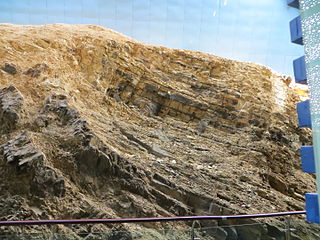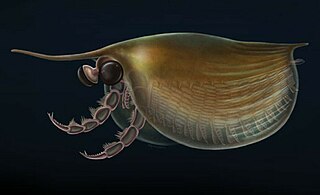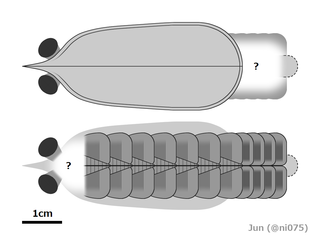
The Maotianshan Shales are a series of Early Cambrian sedimentary deposits in the Chiungchussu Formation, famous for their Konservat Lagerstätten, deposits known for the exceptional preservation of fossilized organisms or traces. The Maotianshan Shales form one of some forty Cambrian fossil locations worldwide exhibiting exquisite preservation of rarely preserved, non-mineralized soft tissue, comparable to the fossils of the Burgess Shale of British Columbia, Canada. They take their name from Maotianshan Hill in Chengjiang County, Yunnan Province, China.

Anomalocaris is an extinct genus of radiodont, an order of early-diverging stem-group arthropods.

Amplectobelua is an extinct genus of late Early Cambrian amplectobeluid radiodont, a group of stem arthropods that mostly lived as free-swimming predators during the first half of the Paleozoic Era.

Anomalocarididae is an extinct family of Cambrian radiodonts, a group of stem-group arthropods.

Tuzoia is an extinct genus of large bivalved arthropod known from Early to Middle Cambrian marine environments from what is now North America, Australia, China, Europe and Siberia. The large, domed carapace reached lengths of 180 millimetres (7.1 in), making them amongst the largest known Cambrian arthropods.

Isoxys is a genus of extinct bivalved Cambrian arthropod; the various species of which are thought to have been freely swimming predators. It had a pair of large spherical eyes, and two large frontal appendages used to grasp prey.

Radiodonta is an extinct order of stem-group arthropods that was successful worldwide during the Cambrian period. They may be referred to as radiodonts, radiodontans, radiodontids, anomalocarids, or anomalocaridids, although the last two originally refer to the family Anomalocarididae, which previously included all species of this order but is now restricted to only a few species. Radiodonts are distinguished by their distinctive frontal appendages, which are morphologically diverse and used for a variety of functions. Radiodonts included the earliest large predators known, but they also included sediment sifters and filter feeders. Some of the most famous species of radiodonts are the Cambrian taxa Anomalocaris canadensis, Hurdia victoria, Peytoia nathorsti, Titanokorys gainessii, Cambroraster falcatus and Amplectobelua symbrachiata, the Ordovician Aegirocassis benmoulai and the Devonian Schinderhannes bartelsi.

Amplectobeluidae is a clade of Cambrian radiodonts.

Lyrarapax is a radiodont genus of the family Amplectobeluidae that lived in the early Cambrian period 520 million years ago. Its neural tissue indicates that the radiodont frontal appendage is protocerebral, resolving parts of the arthropod head problem and showing that the frontal appendage is homologous to the antennae of Onychophorans and labrum of euarthropods. Its fossilized remains were found in Yunnan in southwestern China. A second species was described in 2016, differing principally in the morphology of its frontal appendages.

Ramskoeldia is a genus of amplectobeluid radiodont described in 2018. It was the second genus of radiodont found to possess gnathobase-like structures and an atypical oral cone after Amplectobelua. It was discovered in the Chengjiang biota of China, the home of numerous radiodontids such as Amplectobelua and Lyrarapax.

Cambroraster is an extinct monotypic genus of hurdiid radiodont, dating to the middle Cambrian, and represented by the single formally described species Cambroraster falcatus. Hundreds of specimens were found in the Burgess Shale, and described in 2019. A large animal at up to 30 centimetres (12 in), it is characterized by a significantly enlarged horseshoe-shaped dorsal carapace (H-element), and presumably fed by sifting through the sediment with its well-developed tooth plates and short frontal appendages with hooked spines. It is named partially after the fictional Millennium Falcon, which its dorsal carapace resembles.

Squamacula is an extinct artiopodan arthropod from the Cambrian Series 2. The type species S. clypeata was described in 1997 from the Chengjiang biota of Yunnan, China. At the time of description there were only two known specimens of S. clypeata, but now there are at least six known specimens. In 2012 a second species S. buckorum was described from the Emu Bay Shale of Australia.

Kylinxia is a genus of extinct arthropod described in 2020. It was described from six specimens discovered in Yu'anshan Formation in southern China. The specimens are assigned to one species Kylinxia zhangi. Dated to 518 million years, the fossils falls under the Cambrian period. Announcing the discovery on 4 November 2020 at a press conference, Zeng Han of the Nanjing Institute of Geology and Paleontology, said that the animal "bridges the evolutionary gap from Anomalocaris to true arthropods and forms a key ‘missing link’ in the origin of arthropods," which was "predicted by Darwin’s evolutionary theory." The same day the formal description was published in Nature.

Houcaris is a genus of tamisiocarididid radiodonts known from Cambrian Series 2 of China and the United States. It contains two species, Houcaris saron and Houcaris magnabasis, both of which were originally named as species of the related genus Anomalocaris. The genus Houcaris was established for the two species in 2021 and honors Hou Xianguang, who had discovered and named the type species Anomalocaris saron in 1995 along with his colleagues Jan Bergström and Per E. Ahlberg.

Erratus is an extinct genus of marine arthropod from the Cambrian of China. Its type and only species is Erratus sperare. Erratus is likely one of the most basal known arthropods, and its discovery has helped scientists understand the early evolution of arthropod trunk appendages. Some of the stem-arthropods like radiodonts did not have legs, instead they had flap like appendages that helped them swim. Erratus on the other hand had not only flaps but also a set of primitive legs. It also supported the theory that the gills of aquatic arthropods probably evolved into the wings and lungs of terrestrial arthropods later in the Paleozoic.

Bailongia is an extinct genus of arthropod known from a single species Bailongia longicaudata found in the Cambrian Stage 4 aged Guanshan Biota of Yunnan, China. It was around 5mm long and had a large head shield, nine overlapping tapering tergites and a relatively elongate tailspine. It has been recovered in a relatively basal position within Artiopoda, more derived than Squamacula or Protosutura, but outside Trilobitomorpha or Vicissicaudata.

Laminacaris is a genus of extinct stem-group arthropods (Radiodonta) that lived during the Cambrian period. It is monotypic with a single species Laminacaris chimera, the fossil of which was described from the Chengjiang biota of China in 2018. Around the same time, two specimens that were similar or of the same species were discovered at the Kinzers Formation in Pennsylvania, USA. The first specimens from China were three frontal appendages, without the other body parts.
Innovatiocaris is a genus of radiodont of uncertain family from the early Cambrian Chengjiang Lagerstätte of Yunnan Province, China. The genus contains two named species, I. maotianshanensis, known from a nearly complete individual and isolated frontal appendages, and I.? multispiniformis, known from a complete frontal appendage.

Fengzhengia is an extinct genus of arthropod known from a single species, Fengzhengia mamingae from the Cambrian aged Chengjiang Biota of Yunnan, China. It is thought to be a basal arthropod, as one of the most basal members of Deuteropoda. Like other basal deuteropods such as Kylinxia, Fengzhengia has an upward curling pair of "frontal appendages", contrasting with the downward curving pair of frontal appendages possessed by radiodonts. The head has a pair of stalked eyes. The trunk had 15 tergites the first nine of which had upward facing spines, with the trunk terminating with a tail fan. The trunk seemingly had pairs of biramous limbs, with paddle-shaped exopods. It is thought to have been nektobenthic, and either a scavenger or a predator.

Guanshancaris is an extinct genus of amplectobeluid radiodont known from the Cambrian Stage 4 Guanshan Biota of southern China. It is only known from a single species. G. kunmingensis which was described in 2013 as a species of Anomalocaris before being placed in a new genus in 2023. Like many other radiodonts, it is only known from fragmentary remains, including its frontal appendages and the oral cone. It has been suggested to have been durophagous.





















